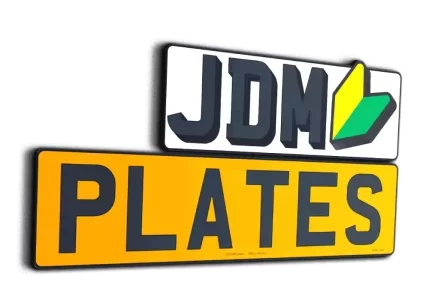Discover the Process Behind Every UK Number Plate
If you’ve ever wondered how car number plates are made, you’re not alone. From standard white-and-yellow plates to custom number plates with 3D characters, there’s much more to the process than simply printing a few letters. Whether you’re ordering your first personalised number plate or just curious about the UK number plate system, this guide walks you through the whole production journey.
At JDM Plates, we’re more than just suppliers; we’re experts in road-legal, high-quality, and fully customisable number plates that comply with British Standards. Here’s everything you need to know about making a number plate legally and correctly.
A Brief History of UK Number Plates
Number plates have been mandatory in the UK since 1903. Initially black with white or silver characters, they evolved to meet modern safety and readability requirements. Today, the current number plate system, introduced in 2001, follows a uniform structure that includes a local memory tag, an age identifier, and a unique sequence of letters.
Reflective materials were introduced in 1973, giving rise to the now-standard white background for front plates and yellow background for rear plates. These colours improve visibility, especially under headlights or low-light conditions.
Legal Requirements: What Makes a Number Plate Road Legal?
To be road-legal in the UK, a number plate must meet strict guidelines set by the DVLA and conform to British Standards (BS AU 145e). This includes:
- Reflective material: White for front, yellow for rear
- Black alphanumeric characters
- Correct font, spacing, and layout
- No background patterns or images
- Plate made by a registered number plate supplier
At JDM Plates, all our products meet or exceed these requirements.
How Are Car Number Plates Made? Step-by-Step
Step 1: Verifying Your Details
To buy a custom number plate, you’ll need to provide:
- Proof of ID (e.g., a driving licence)
- Proof of entitlement to the registration number (e.g., V5C logbook)
Only a registered number plate supplier like JDM Plates can legally produce your plate.
Step 2: Choosing Your Style
You can personalise your plate by selecting:
- Plate type: 3D Gel, 4D Laser Cut, or Standard
- Font and legal spacing
- Optional border or badge
Step 3: Preparing the Materials
- Acrylic base layer
- White or yellow reflective backing
- Optional gel or laser-cut acrylic characters
- Transparent overlay to protect from scratches and UV damage
Step 4: Printing and Assembly
- Registration number printed or applied using precision machines
- Characters positioned with exact spacing
- Bonding or pressing methods are used depending on the style (e.g., 4D plates are layered)
Step 5: Quality Check and Packaging
- The plate is inspected for defects, incorrect spacing, or blemishes
- Final assembly includes fitting holes or pads if required
Inside the UK Number Plate System
Every car number plate made in the UK follows a standardised format:
- Two letters: Local memory tag (e.g. “LC” for London)
- Two numbers: Age identifier (e.g. “73” for a September 2023 registration)
- Three random letters: Unique sequence
Example: LC73 ABC
- LC = Car registered in London
- 73 = Registered between September 2023 and February 2024
- ABC = Random, system-generated characters
This format provides a unique identity and ensures plates are trackable and compliant.
Can You Make Your Own Number Plate?
Technically, no. While it’s possible to design your own number plate, only a registered supplier can legally manufacture it. DIY versions may:
- Fail to meet legal spacing/font
- Lacks proper reflective material
- Be subject to fines and MOT failure
Your safest route? Use a reputable supplier like JDM Plates for road-legal, stylish, and durable results.
Shop our legal and customisable options
What Materials Are Used?
Most number plates today are made using:
- Acrylic as a rigid, clear base
- Reflective sheeting: white or yellow background, depending on front/rear
- Black characters: printed, gel-raised, or laser cut
- Adhesives: for character bonding and final assembly
- Protective coating: guards against weather, dirt, and UV damage
Some plates include 3D or 4D effects or extra-durable finishes for added flair.
What’s the Difference Between Standard and Personalised Plates?
All plates are produced to the same quality standards, but private number plates.
- Use a different registration (not linked to age or area)
- May include names, initials, or phrases
- Still must comply with UK plate regulations
JDM Plates ensures that even personalised plates meet road-legal standards.
FAQs: Car Number Plate Production
How long does it take to make a number plate?
Once you’ve provided valid documents, such as your driving licence and proof of entitlement to the registration number, a registered number plate supplier like JDM Plates can typically complete the production process within 1–2 business days. This includes sourcing the necessary components, applying the required coloured reflective film, and preparing any custom options like three-dimensional characters. Delivery times may vary depending on demand and location.
Are all number plates reflective?
Yes. Under UK law, all legal number plates must use coloured reflective materials, a white background for the front and a yellow background for the rear. The government introduced this standard to improve road safety and visibility, especially at night. The reflectivity must meet British Standards, and a registered supplier must produce the plate to ensure compliance.
Can I choose my font or colour?
Not completely. While you can personalise your custom plate with optional design features such as borders or legal national flags, the vehicle licensing agency and DVLA strictly control the font style, size, and spacing. You may also opt for 3D or 4D plates with raised or three-dimensional characters, but the characters themselves must still follow the required format and maintain legibility.
Do 3D or 4D plates follow the same rules?
Yes. All new plates, whether flat, 3D, or 4D, must adhere to the display requirements outlined by the DVLA and UK vehicle licensing agency. This includes correct character spacing, reflective backing, and approved materials. At JDM Plates, all our plates comply fully with these legal requirements, whether you choose a sleek flat plate or one with bold three-dimensional characters.
Are plates made differently for electric or vintage cars?
While the production process remains largely the same, there are some variations. Electric vehicles are eligible for green number plates, which feature a coloured reflective green stripe on the left-hand side to indicate zero emissions. For vintage cars, customers may opt for black plates with white or silver characters, provided the vehicle qualifies as historic under current government guidelines. These options are part of our range of styles available to suit different vehicles and uses.
Can I choose the letters and numbers on my plate?
Yes, if you’re buying a custom plate or private registration number. These plates often feature a unique combination of letters and numbers, chosen for names, initials, or meanings. The format in the current system usually includes:
- First two letters (the local memory tag identifying the region where the vehicle was first registered)
- Two numbers (the age identifier)
- Final three letters (a random set to ensure uniqueness)
You can purchase specific combinations from the DVLA or authorised retailers. At JDM Plates, we also offer a Number Plate Generator to help you visualise your custom plate before you buy.
Are there rules about how the plate is displayed?
Absolutely. Your number plate must be clearly displayed on both the front and rear of your vehicle, fixed securely, and visible from a distance. Tampering with the plate to obscure characters, alter spacing, or use unauthorised fonts is illegal and may lead to fines or MOT failure. The vehicle licensing agency guides proper plate display, and our team is always happy to explain the details if you’re unsure.
What documents do I need to order a number plate?
All registered suppliers must verify identity and entitlement to fill your order legally. You’ll need:
- Proof of identity (such as a driving licence)
- Proof of vehicle ownership or registration entitlement (like a V5C logbook)
We’re committed to responsible supply and cannot sell road-legal plates without the proper checks, in line with government and DVLA policy.
Can I get number plates for show use only?
Yes. At JDM Plates, we also offer show plates that are purely decorative and don’t need to follow legal requirements. These can feature stylised combinations, logos, or colours prohibited on road-legal UK number plates. However, these must not be used on public roads and are intended for display, events, or photography. We’ll always make the difference between legal and show plates clear when you purchase.
Trust the Experts at JDM Plates
From understanding how plates are made to choosing the right style for your vehicle, JDM Plates makes the entire process simple, fast, and compliant. Whether you need a new number plate, a private number plate, or a custom design, we’ve got you covered.

